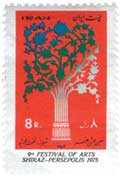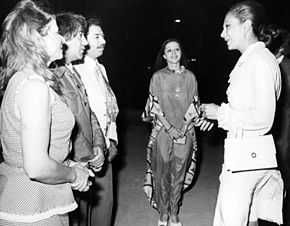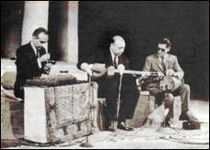Shiraz Arts Festival

The Shiraz-Persepolis Festival of Arts (Persian: جشن هنر شیراز) was an international summer arts festival held annually for eleven years from 1967 to 1977 in the city of Shiraz and Persepolis in central Iran. Accompanied by symposia and debates, the festival program included music, dance, drama, poetry and film, performed in a variety of venues in Shiraz and surrounding areas. The venues included the ruins of Persepolis (ceremonial capital of ancient Persia), Naqsh-e Rostam, Hafezieh, Bagh-e Delgosha, Narenjestan, Bazaar-e Vakil, Jahan-Nama Garden, Saray-e Moshir and a concert hall on the Shiraz University campus. Focused on presenting the best of the traditional and of the avant-garde, the festival attracted world class artists from the East and the West. Very importantly for its impact on the performing arts in the country, the festival sought out and showcased gifted Iranian artists old and young who relished sharing the stage with fellow artists from China and India, Japan and Vietnam all the way through Africa and the Middle East, Europe and Latin America. The exposure to the traditional as well as the novel at such high standards of creativity and inspiration, the opportunity to experiment, and very significantly, the numerous works premiered during the eleven year-long life of the festival were grounds for a fertile cross-pollination whose impact on artistic production in Iran as elsewhere was evident at the time and can still be felt today.
Some of those who appeared at the festival are: In theatre, Jerzy Grotowski, Peter Brook, Tadeusz Kantor, Arby Ovanessian, Bijan Mofid, Davoud Rashidi, Peter Schumann, Parviz Sayyad, Andrei Șerban, Robert Wilson, Shūji Terayama, Andre Gregory, Ali Nassirian, Víctor García, Joseph Chaikin, and Esma'il Khalaj. In this field, traditional plays such as ta'zieh (passion plays) from Iran, Kathakali from India, and Noh from Japan, as well as R. Serumaga with the National Theatre of Uganda, Duro Lapido & the National Theatre of Nigeria, and Pabuji Ki Phad from India were presented, amongst many others .
In music, all the best of Iran's traditional master musicians were presented, amongst them Hassan Kassai, Jalil Shahnaz, Ahmad Ebadi, Faramarz Payvar, Ali-Asqar Bahari, Hossein Tehrani, Hossein Qavami and Abdolvahab Shahidi. The young masters included Hossein Alizadeh, Dariush Talai, Mohammad-Reza Lotfi, Majid Kiani, Mohammad-Reza Shajarian, Parisa and Noureddin Razavi-Sarvestani. Music and rituals from various regions of Iran from Azarbaijan to the Persian Gulf also was present throughout the festival. Indian classical musicians were prominent. Some of those who appeared were Vilayat Khan, Bismillah Khan, Sharan Rani, Pran Nath, Sundaram Balachander, Ravi Shankar, Ram Narayan, Chaurasia and Dagar. Traditional non-Western music, some including dance, were presented from Afghanistan, Algeria, Bhutan, China, Egypt, Indonesia, Iraq, Japan, S, Korea, Morocco, Nepal, Pakistan, Philippines, Rwanda, Senegal, Tunisia, Turkey, Vietnam.
In the field of Western music Yehudi Menuhin, Christian Ferras, Martha Argerich, Arthur Rubinstein and Yvonne Loriod appeared in concert or recital- as did many others. The National Iranian Radio & Television Chamber Orchestra was a regular. Other participants in this field from Iran were Vahe Khochayan, Morteza Hannaneh, Nasrin Azarmi, Novin Afrouz, Guity Adjoodani, Manuchehr Sahba'i, Farhad Mechkat, Hossein Sarshar, Heshmat Sanjari and the Tehran Symphony Orchestra. From the West, Gilbert Amy led the Orchestre du Domaine Musical, Bruno Maderna conducted the ORTF Orchestra as well as the Hague Residence Orchestra, Iannis Xenakis created "Persephassa" and "Persepolis", Karlheinz Stockhausen was prominently featured one year, Krzysztof Penderecki led the Polish National Radio Symphony, Cathy Berberian, the London Sinfonietta, the Melos Ensemble, Morton Feldman & the Creative Associates appeared as well as John Cage, the Juilliard String Quartet, the American Brass Quintet, Max Roach Quintet & Abbey Lincoln and the Staple Singers, amongst others.
In Western dance, Bejart and his Ballet du XXe siecle appeared several times, premiering "Golestan", based on Iranian traditional music and presenting several of his other choreograpies. There was Capoeiras from Bahia, Brazil, Merce Cunningham Dance Co., Alwin Nikolais Dance Theatre and Carolyn Carlson. Non-Western dance included "Cham" from Bhutan, Korean Court Music & Dance (Hyangak Jeonajae), Balinese dances, Purulia "Chhau", Ballet National de Senegal and a host of top classical dancers from India, including Uma Sharma, Shanta Rao, Yamini Krishnamurti, Sanjukta Panigrahi and Sonal Mansingh.
The twelfth festival was cancelled at the onset of the Islamic Revolution in 1978 out of concern for the safety of the performers.[1]
Gallery
-

Shahre Gheseh by Bijan Mofid, 1968
-

Moon and Leopard by Bijan Mofid, 1970
-

Persepolis Event, Douglas Dunn (left), Carolyn Brown (rear) and Merce Cunningham (right)
-

Stockhausen's Mantra on 2 September 1972, Aloys and Alfons Kontarsky, pianos, electronics by the composer (foreground)
-

David Tudor (left) and John Cage performing at the 1971 festival
-

Farah Pahlavi talking to Farzaneh Taidi, Ali Nassirian, and Ezzatolah Entezami
-
Ravi Shankar performs at the Shiraz Arts Festival in the 1970s
-
Ram Narayan performs at the Shiraz Arts Festival in the 1970s
-

Parisa performs at the Shiraz Arts Festival 1967
References
- ↑
- Gluck, Robert (2007). "The Shiraz Arts Festival: Western Avant-Garde Arts in 1970s Iran" (PDF). Leonardo.
External links
| Wikimedia Commons has media related to Category:Shiraz Arts Festival. |
- NZ On Screen. Sound the Trumpets, Beat the Drums, Tony Williams' film documentary of the 1969 festival


